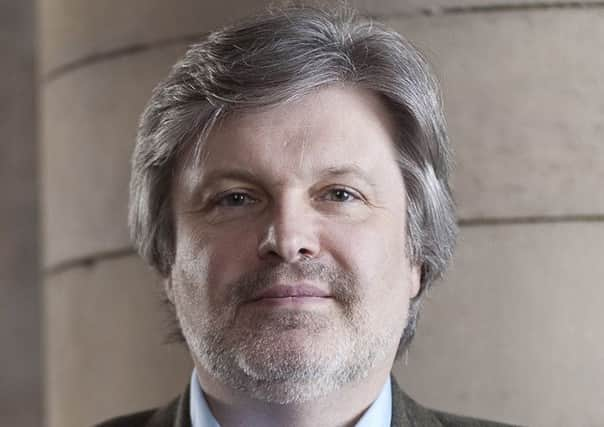Review: The Cumnock Tryst Festival


The Barony A Frame ****
Cumnock Town Hall
RCS Music Lab ****
Cumnock Old Church
Festival Chorus & Leigh Melrose ****
Auchinleck Parish Church
They were his trombone quartet (though their skills go far beyond playing trombones) Pandora’s Box, and HeadSpace, a group centring on the extraordinary Clarence Adoo, whose trumpet playing career came to an abrupt end after an accident left him paralysed from the neck down.
Adoo now creates music through a computer-aided “instrument” called HeadSpace from his wheelchair.
Advertisement
Hide AdAdvertisement
Hide AdThe central piece in the programme, The Barony A Frame, had a potent local relevance. A festival commission from Irvine-born Scott Lygate, and performed by Pandora’s Box, it takes its inspiration from the iconic metal tower that dominates the skyline outside Cumnock at the former Barony coal mine.
Its magnified soundscape, created with the aid of
primitive metallic percussion and endless unorthodoxy of technique, presents a vivid and volatile cluster of memories that alludes to the breathy hissing of steam and the grinding of machines, to social cohesion and to horrifying tragedy.
The work was performed twice for audiences – a helpful gesture – around which Kenny (who was also playing the fearsome bronze carnyx) and his colleagues made theatrical mischief of Britten’s Fanfare for St Edmunsbury and
Torbjörn Hultmark’s body
percussion spectacular A Fairy Tale, complete with whimsical narration and mime.
Kenny’s HeadSpace and hugely atmospheric Salt Road completed an unexpectedly fun evening.
First port of call on Day Three was the Ayrshire town’s Old Church, a rugged Presbyterian edifice with stern upright pews. The cobbled square outside, bathed in sun, seemed lazy and empty, but inside there was an invigorating and splendid showcase of compositional talent from the Royal Conservatoire of Scotland.
They may all be students –the contemporary ensemble Music Lab, conductors Simon Proust and Raffaele De Giacometti, and the composers themselves – but this was all music you’d happily pay to hear.
Advertisement
Hide AdAdvertisement
Hide AdTryst director, Sir James MacMillan, introduced each of composers and their works, the end result of a collaboration involving pre-Festival workshops with MacMillan himself. There were some which stood out for their assuredness and creative
individuality, but with the
benefit of such efficient and energised performances, all were heard at their optimal best.
Each of the composers introduced their works in conversation with MacMillan. Matthew Grouse, for instance, talked about “the current turbulence of socio/political events” in his slowly-progressing Krantz. Maybe so, but I was more taken by its logical musical argument and sensitivity to texture, impressionistic in parts.
Electra Perivolaris’ Shapes Form Over The Open Landscapes - those being the Ayrshire ones where she lives - was striking and sure-handed, often elusive and mercurial, held together by a potently recurring semitonal dissonance.
Charles Baumstark’s Duo for alto saxophones, a virtuoso tit-for-tat dialogue between equals, benefitted from a brilliant performance by Fran Sanchez Diaz and Lewis Banks. Rylan Greave’s deeply-motivated Ceramic Membrane occupied a more abstract, but sensibly argued, plane.
The final two pieces bristled with character: Max Welton’s Victrola, a wacky whimsical “soundtrack” to the poem Joseph Moncure March’s poem The Wild Party, set in sleazy ‘20s jazz mode with snatches of Gershwin fed through the parodic wringer; and Nicholas Olsen’s 52:48 (Or How To Be Ignorant), a skilfully crafted, amusingly ironic musical response to empty political rhetoric.
The Festival moved swiftly to nearby Auchinleck Parish Church for the Scottish Premiere of Cecilia McDowall’s Stabat Mater, featuring the packed forces of the Festival Chorus, Genesis Sixteen, RSNO Junior Chorus, NYOS Camerata and baritone Leigh Melrose, under Eamonn Dougan’s tightly controlled direction.
Advertisement
Hide AdAdvertisement
Hide AdIt is signature McDowall, accessible singable music, sensitive to the text, its outward simplicity offset by softly insistent dissonance that gives character and substance to the score. The main choir was wholesome and robust in the opening chorus and thrillingly unanimous in the two Chorales.
The Eia Mater, sung with brimming confidence from the side gallery by the young RSNO voices, bore a beautiful childlike innocence. Melrose’s central solo, cast a majestic aura from on high in the church’s towering pulpit. When all these forces came together in the radiant conclusion, and with the low October sun beaming through the rear stained glass window, it was as like being embraced by a warm spiritual blanket.
MacMillan conducted the opening work, Copland’s characterful American Songs, with the hi-octane Melrose again as soloist.